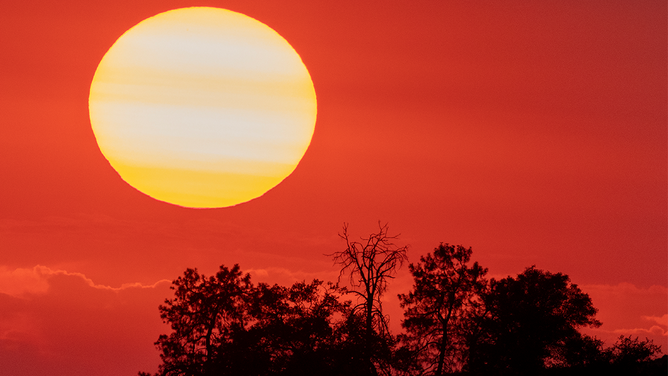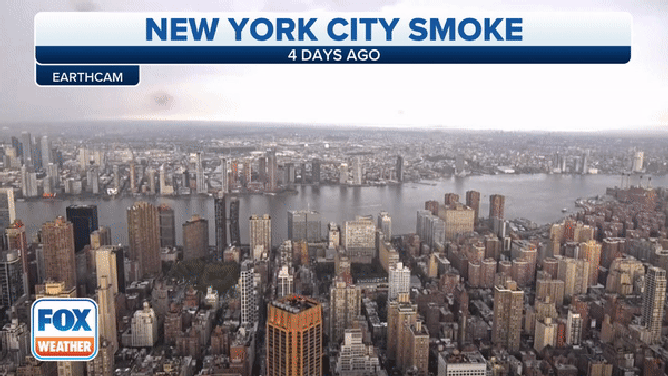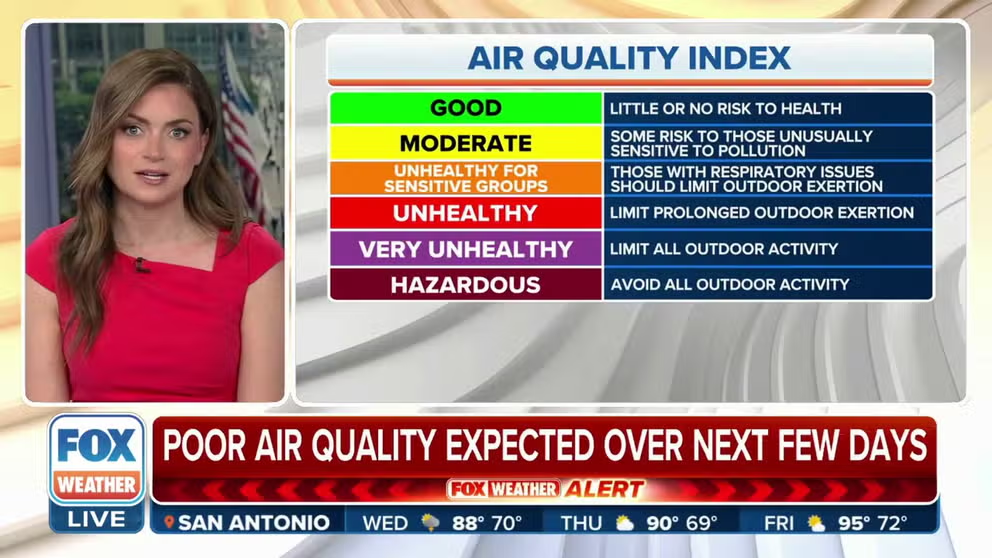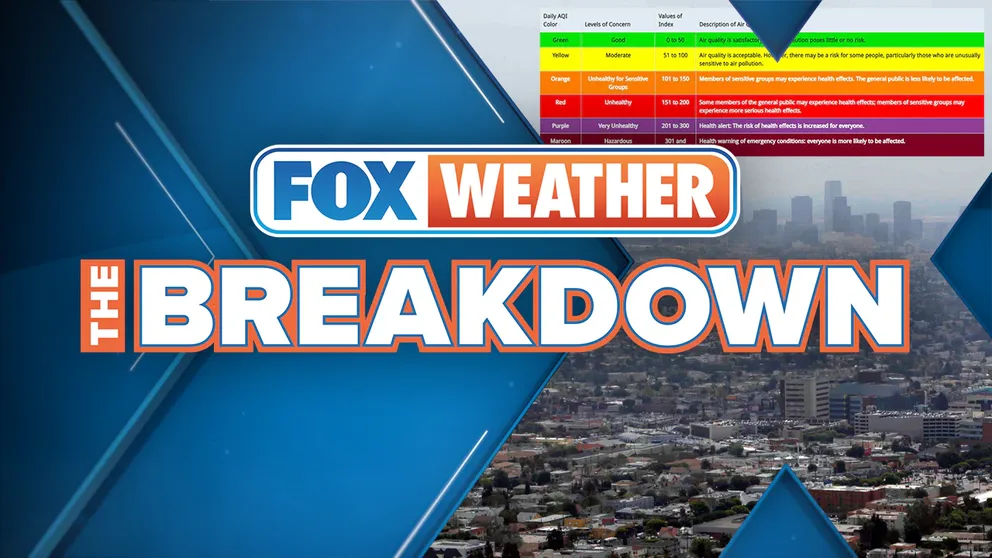Which cities have the worst air pollution in America?
The American Lung Association has released its annual State of the Air report for 2023, ranking cities across the country that have the worst air pollution as well as cities with the cleanest air.
What is the air quality index?
The air quality index (AQI) ranges from 0 to 500 and has six color-coded categories to correspond to a different set of health concerns that people should consider when being outside for extended periods of time. Here’s a closer look at each category and how you should react to each one.
The American Lung Association has released its annual State of the Air report for 2023 and ranked cities with the worst air pollution as well as the cities with the cleanest air across the U.S.
Analysts collected daily and annual air pollution data from 2019-2021 for what the association called the most widespread and dangerous air pollutants – fine particles and ozone. They ranked each metropolitan area from the most polluted to the cleanest for annual particle pollution, annual ozone pollution and short-term particle pollution.
120 MILLION AMERICANS LIVE IN A COMMUNITY WHERE AIR IS DEEMED UNHEALTHY
How is air quality measured?
Learn how air quality is measured.
Top 25 cities with the worst air pollution
Los Angeles takes the top spot for the worst ozone pollution this year, as it has for 23 of the 24 years this report has been calculated.
Several places in California's Central Valley take top spots for particle pollution. Bakersfield and Fresno top the list for failing short-term particle pollution grades. Visalia and Bakersfield share the crown for worst annual particle pollution.
7 FACTS THAT EXPLAIN HOW AIR QUALITY IS MEASURED

FILE - The sun sets behind smoke from a distant wildfire as drought conditions worsen on July 12, 2021 near Glennville, California.
(David McNew / Getty Images)
"Although cities most affected by western drought and wildfires, including eight in California, three in Oregon, and three others in Alaska, Arizona, and Washington, still represented the largest share, cities with high power plant emissions as well as local industrial and mobile sources of year-round particle pollution continued to show up on this list," stated the report about annual particle pollution.
Only Pittsburgh and Lancaster, Pennsylvania, made the short-term particle pollution fail list east of the Mississippi River.
THE AIR QUALITY INDEX EXPLAINED
These cities have the cleanest air in the US
Seven cities are on the cleanest-air list for all three measures: annual particle pollution, ozone pollution and short-term particle pollution. All had zero days in high particle and ozone pollution.
- Asheville-Marion-Brevard, North Carolina.
- Bangor, Maine.
- Greenville-Kingston-Washington, North Carolina.
- Lincoln-Beatrice, Nebraska.
- Rochester-Batavia-Seneca Falls, New York.
- Urban Honolulu, Hawaii.
- Wilmington, North Carolina.
Elmira, New York; Burlington, Vermont; Charlotte-Harrisonburg-Roanoke, Virginia, and Virginia Beach, Virginia, dropped off the cleanest list.
Dangers of pollution
Particles
Particles from exhaust, smoke, dust storms and construction that are smaller than the width of a human hair can not only be inhaled but get trapped in the lungs. The finest particles can pass through the lungs into the bloodstream, according to the American Lung Association.
Inhaling fine particulate matter and pollution (less than 2.5 micrometers in diameter) and ozone at high levels can cause lung irritation that may take days to recover from. Research published by the National Institutes of Health indicated that both short-term and long-term air pollution exposure is linked to premature death.
Researchers found a "significant" increase in deaths within two days of high air pollution levels for people over 65 years old. The number of deaths rose as the ozone and particulate levels increased.
DOCTORS WARN THAT WILDFIRE SMOKE CAUSES ‘ACCELERATED SKIN AGING’

Wildfire smoke from Canada is having a widespread and significant impact on air quality in New York City. Look at the before and after photos.
(FOX Weather / FOX Weather)
"We found that the mortality rate increases almost linearly as air pollution increases," wrote Dr. Francesca Domenici, author of the study. "Any level of air pollution, no matter how low, is harmful to human health."
Another study linked low birth weight in newborns and preterm labor for moms to air pollution.
Ozone
Ozone at the Earth’s surface mixes with other pollutants (nitrogen oxides emitted by cars, power plants and other high-heat combustion) and VOCs (volatile organic compounds emitted by cars, factories, refineries and paint) to create smog. Ozone is harmful to inhale in high concentrations and can even be deadly.
WHAT TO DO WHEN WILDFIRE SMOKE SMOTHERS YOUR AREA AND HOW TO KEEP YOUR HOME'S AIR CLEAN

File: Tourists try to take selfies in front of the "Hollywood" sign in Los Angeles through the smog.
(Allen J. Schaben / Los Angeles Times via Getty Images / Getty Images)
Ozone, composed of three oxygen molecules, attacks lung tissue. Most at risk are kids, seniors, people who work or exercise outdoors and those with existing lung disease. The more a person breathes in, the more at risk they are of damage.
The most likely area to experience smog is downwind of the source, which can be miles away.
Besides premature death, ozone can cause shortness of breath, asthma attacks and can lead to an increased risk of respiratory infections for all ages. The EPA also reported that ozone pollution may cause cardiovascular harm (heart attacks, strokes) and damage the central nervous system.

LONG BEACH, CALIF. - SEPT. 1, 2022. The downtown Los Angeles skyline shimmers in the smog as a plane taking off from Long Beach Airport climbs out of the haze after another hot day across Southern California. A brutal heatwave is expected to last through. the Labor Day weekend. (Luis Sinco /. Los Angeles Times via Getty Images)
One in three people, or 119.6 million of us, live in cities that the report gave failing grades for unhealthy levels of ozone and particle pollution. The report found that 63.7 million Americans are living in counties with "daily spikes in deadly particle pollution," which is the most ever reported under current national standards.
There is a silver lining, 17.6 million fewer of us breathe unhealthy air compared to last year's report.

